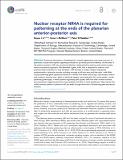Nuclear receptor NR4A is required for patterning at the ends of the planarian anterior-posterior axis
Author(s)
Li, Dayan; McMann, Conor L.; Reddien, Peter
DownloadPublished version (19.66Mb)
Terms of use
Metadata
Show full item recordAbstract
Positional information is fundamental to animal regeneration and tissue turnover. In planarians, muscle cells express signaling molecules to promote positional identity. At the ends of the anterior-posterior (AP) axis, positional identity is determined by anterior and posterior poles, which are putative organizers. We identified a gene, nr4A, that is required for anterior- and posterior-pole localization to axis extremes. nr4A encodes a nuclear receptor expressed predominantly in planarian muscle, including strongly at AP-axis ends and the poles. nr4A RNAi causes patterning gene expression domains to retract from head and tail tips, and ectopic anterior and posterior anatomy (e.g., eyes) to iteratively appear more internally. Our study reveals a novel patterning phenotype, in which pattern-organizing cells (poles) shift from their normal locations (axis extremes), triggering abnormal tissue pattern that fails to reach equilibrium. We propose that nr4A promotes pattern at planarian AP axis ends through restriction of patterning gene expression domains.
Date issued
2019-04Department
Whitehead Institute for Biomedical Research; Massachusetts Institute of Technology. Department of BiologyJournal
eLife
Publisher
eLife Sciences Publications, Ltd
Citation
Li, Dayan J. et al. “Nuclear receptor NR4A is required for patterning at the ends of the planarian anterior-posterior axis.” eLife 8 (2019): e42015 © 2019 The Author(s)
Version: Final published version
ISSN
1534-4983